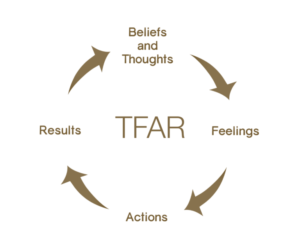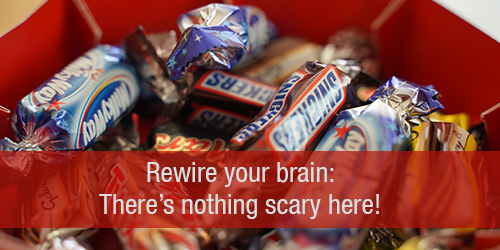Around Halloween, every time you go to the store or open your cabinets you’re faced with bags of Halloween candy (or your kids’ Halloween haul!). If the sight of candy is scary, it’s time to rewire your brain to change your habits!
If you don’t like your results, what you were thinking first?
Seeing candy can be a trigger for overeating if you’ve struggled with an eat-repent-repeat cycle. It can set off a chain reaction of thoughts and feelings, conflict and struggle, and sometimes overeating.
 And it all starts with a thought.
And it all starts with a thought.
Pause for a moment to consider the thoughts that arise when you see Halloween candy…
- Oh no! If I start eating it, I won’t be able to stop!
- I shouldn’t eat candy; it’s bad for me.
- I’m addicted to sugar.
- Oh well! I’ll eat it now then get back in control in the New Year.
How your thoughts become your habits
It’s essential to realize that your thoughts are very powerful. They have the ability to drive your behaviors and your outcomes. It’s a chain reaction we call TFAR: Your Thoughts lead to your Feelings, which lead to your Actions, which lead to your Results.

Therefore, you create your own reality by what you think.
This is not as woo-woo as it sounds! Here’s how it works:
- What you think causes you to feel a certain way.
- That in turn, causes you to do certain things.
- What you do leads to specific results.
- Your results reinforce your initial thoughts.This is how your thoughts become self-fulfilling prophecies.
- With repetition, your thoughts become beliefs, so you don’t have to consciously think the thoughts anymore!
Beliefs then drive automatic behaviors—in other words, habits.
What does this have to do with Halloween candy?
If you see Halloween candy, and think, “Oh no! If I start eating it, I won’t be able to stop!” how does that make you feel?
 Perhaps you feel fearful, weak-willed, discouraged, deprived, and so on.
Perhaps you feel fearful, weak-willed, discouraged, deprived, and so on.
Then how do you act? Maybe at first you avoid the candy or eat other substitutes. As the season goes on and Halloween candy is everywhere, the feelings of deprivation and cravings grow stronger.
Eventually, when stress, hunger, and temptation collide, you decide to have “just one piece.” Of course, it tastes delicious, so you decide to have another. Then another. You begin to worry: Once I start eating candy, I just can’t stop. So you don’t. And you’ve proved your original thought right, reinforcing the belief that you shouldn’t eat candy or you’ll lose control.
In the past, you may have spent the rest of the holidays eating everything you told yourself you “shouldn’t,” and planning to ban it all in the New Year.
Your New Years Resolution to avoid candy and other sweets helps at first, but eventually, you find yourself back in the same cycle: Avoidance > deprivation > cravings > eating the restricted food > guilt > avoidance.
The problem is that it’s common for people to try to change their actions and the results they don’t like without first recognizing and dealing with the beliefs, thoughts, and feelings that led to those unwanted actions and results in the first place. To create lasting change, it is essential to rewire your brain!
How mindfulness helps change habits
For many people, eating is a mindless reaction to their unrecognized or unexamined thoughts. You might repeatedly react mindlessly to your thoughts and beliefs. In other words, you re-act, repeating past actions again and again—feeling powerless to change.
Granted, it’s not always easy to recognize when a thought is driving unwanted results, especially if you’ve been thinking a particular way for a long time. Thinking thoughts that lead to undesirable results is a habit—a habit that can be changed with mindfulness.
Mindfulness is awareness of what is happening in the present moment—including awareness of your thoughts.
Mindfulness is helpful for rewiring your brain and changing your habits because when you pause to notice what is happening, you create space between your thoughts and your actions. By increasing your awareness of your thoughts, you can begin to break old automatic or habitual chain reactions between your triggers, thoughts, feelings, actions, and results.
Rewire your brain
What new thought could replace the old thought, “Once I start eating candy, I just can’t stop”?
How about this new thought: “In the past, due to restriction and deprivation, I had trouble stopping when I ate candy. Now, I eat what I love and candy doesn’t have power over me!”
Each time you choose not to activate your old trigger-thought-feeling-action-result sequence, you weaken the connections. It’s as if the wires rust and eventually break.
Further, each time you choose a different thought>feeling>action, you create a new connection. With repetition, you’ll hard wire these new pathways—like insulating your brain’s wiring. Your new thoughts and responses become your new habits.
(This article is based on the book series, Eat What You Love, Love What You Eat.)
Enjoyed this article? Here are three more to help you:
The Trick to Managing the Treats
Halloween Candy and Kids: A Fearless Approach
Updated from a previously published version.


